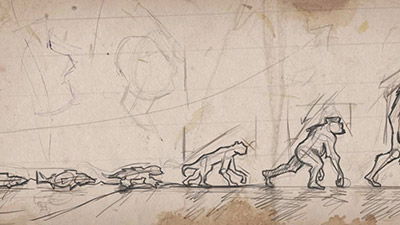Hype and Science Don't Mix
ICR: “‘Missing Link’ Ida Is Just Media Hype” The news media has been awash this week in hype over an alleged missing link fossil nicknamed Ida. As it turns out, the fossil wasn’t fraudulent, but the hype definitely was.
For only the second time that we can remember, the same science story has headlined News to Note more than one week in a row (the other time was the hullabaloo over the 200th anniversary of Darwin’s birth earlier this year).
The purported “missing link” fossil was unveiled to the public.
Last week we reported on the lemur-like Darwinius masillae fossil—at that time, essentially just a rumor. Then, on Tuesday of this week, the purported “missing link” fossil was unveiled to the public by the New York City mayor, of all people.
The unveiling was set to coincide with the publication of a paper on the fossil in the journal PLoS One. But that was just the start. A well-coordinated effort simultaneously flooded media outlets, promoting not so much the fossil (nicknamed “Ida”) and the paper, but the major book and television documentary that had been produced for public consumption.
In effect, many of the early reports (Sky News carried one) were little more than advertisements for the documentary using the pre-fabricated quotes provided by the documentary backers at revealingthelink.com and offering no critical commentary. The Answers in Genesis librarian reported that as of Wednesday morning, more than 630 online news sites had covered the fossil. Search engine Google even became swept up in the hype, changing their search page banner image to show Ida. The fossil was also showcased on ABC–TV’s Good Morning America Wednesday morning.
Other journalists weren’t so credulous, however, and soon reports appeared quoting scientists who challenged both the ostentatious conclusions of the Ida researchers and the scientific procedure behind the paper.
As for Answers in Genesis, we posted a preliminary report on Ida on Tuesday, amid the media hubbub. In Ida (Darwinius masillae): the Missing Link at Last? we reviewed the fossil as a whole, including what supposedly made it a “missing link.” We also reminded readers of how fossils do not show evolution; rather, the presupposition of evolution is used to interpret fossils. AiG cofounder Ken Ham was quoted by a number of media sources, from OneNewsNow to the Washington Times.
Our paleontological conclusion now is the same as our conclusion then, which in turn was the same we had posited in last week’s News to Note: “it was a small, tailed, probably tree-climbing, and now extinct primate—from a kind created on Day 6 of Creation Week.” Perhaps not a lemur per se, but clearly from the same created kind of Genesis 1.
The bigger story now is how so much of the media was irresponsibly caught up in the hype—and why there was a coordinated media effort in the first place. While the fossil is definitely not a fraud, it appears the hype was: the dramatic “missing link” conclusions presented to the public were not present in the scientific paper, having been removed during the peer review process. Our guess is that after paying an undisclosed but presumably significant sum for the fossil, the financial backers are demanding a high return on the documentary and book—hence the hype, such as comments like, “When our results are published, it will be just like an asteroid hitting the earth” (from study coauthor Jens Franzen, via the promotional website).
“It’s not a missing link, it’s not even a terribly close relative to monkeys."
The Institute for Creation Research agrees: “[One of the scientists] purchased the fossil for an undisclosed sum from the dealer based on seeing only three photographs and not the actual fossil, a ‘huge gamble’ that suggests pressure to make some kind of return on the university’s investment.” The original asking price for the fossil was $1 million, though it was found by amateurs back in 1983.
Even one of the paper coauthors admitted, “There was a TV company involved and time pressure. We’ve been pushed to finish the study. It's not how I like to do science.” That same author noted that the team would have preferred to publish in a more rigorous journal than PLoS One.
Instead, the better journalists and more skeptical scientists responded in just the opposite way, accusing the study authors of “cherry picking” which facts to highlight. “It’s not a missing link, it’s not even a terribly close relative to monkeys, apes and humans, which is the point they’re trying to make,” said Chris Beard, a curator of vertebrate paleontology at the Carnegie Museum of Natural History. He added, “I would be absolutely dumbfounded if it turns out to be a potential ancestor to humans.”
That’s just one of the sharp rebuttals to the supposed “missing link”—we published a list of many such responses in Ida (Darwinius masillae): the Real Story of this “Scientific Breakthrough”. Given the criticism evolutionists have already offered of this missing link claim, there’s little more we need to add. The fossil is real (and remarkably well preserved, as we pointed out in our initial article), but the hype of this being a missing link is a hoax.
For more information:
Remember, if you see a news story that might merit some attention, let us know about it! (Note: if the story originates from the Associated Press, Fox News, MSNBC, the New York Times, or another major national media outlet, we will most likely have already heard about it.) And thanks to all of our readers who have submitted great news tips to us.
(Please note that links will take you directly to the source. Answers in Genesis is not responsible for content on the websites to which we refer. For more information, please see our Privacy Policy.)
Recommended Resources

Answers in Genesis is an apologetics ministry, dedicated to helping Christians defend their faith and proclaim the good news of Jesus Christ.
- Customer Service 800.778.3390
- Available Monday–Friday | 9 AM–5 PM ET
- © 2026 Answers in Genesis







